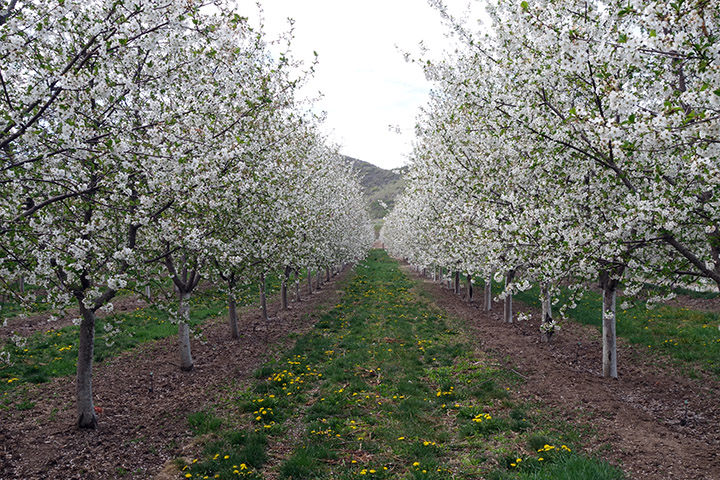Orchard Floor Management: Cover Crops

Cover crops in the alleys are an important component of orchard floor management. Cover crops are important in maintaining soil structure, encouraging water infiltration, reducing erosion, reducing mud and dust, and maintaining an acceptable driving surface for equipment. Alley cover crops are typically perennial. A good cover crop can be established with grasses, broadleaf plants such as legumes, or both, although a selecting just one of these is often easier to manage than cover crop made up of multiple crop species. A cover crop should establish itself quickly and thereafter should not require much maintenance. It should be chosen and managed so that competition with trees is minimal and does not encourage pests (e.g. rodents). Choice of alley cover often depends on if alleys are irrigated. Drought tolerant species, like hard fescue, should be used if alleys receive only rain/snow.
Grasses are the most common cover crops in orchards. Many different grasses and grass mixtures are available, so orchardists can choose what is best suited to each particular situation. Several low growing perennial rye grasses and fescues are available and allow easy orchard access even when headed out. Many orchards use grass cover alone as it allows easier control of broadleaf weeds with selective herbicides.
Legumes can be used as alleyway cover crops to grow additional nitrogen in the orchard. Mowing and discharging the nitrogen-rich plant material in the tree row effectively bands the nitrogen next to the tree roots. Plant adaptability to the Intermountain West climate greatly influences the legumes that can be considered. Alleyway-grown alfalfa has been shown to produce 50 pounds of nitrogen per acre in an orchard system. A drawback to this type of system is the lack of control over the timing of nitrogen availability. If the nitrogen becomes available late in the season, then this could create a flush of shoot growth that would delay hardening off of the orchard tree and increase susceptibility to early winter injury. Considerations on the time of mowing could appropriately add the nitrogen according to tree needs, and limit potential negative effects. Alfalfa does not hold up well to wheel traffic and is not shade tolerant enough to persist in older orchards.
Use of legume covers does come with a few disadvantages. Stink bugs and lygus can feed on the legumes, and after mowing, could move to the trees and feed on fruits, causing cat-facing injury. Legumes are also preferred food for pocket gophers and voles. Legumes require more irrigation than some other cover crops. In an established orchard environment, alfalfa and alfalfa-clover mixes were shown to transpire more than twice as much water as a conventional grass alleyway. Although legumes add nitrogen to the orchard soil, the fertility benefits may not outweigh the cost of managing increased pest populations or maintaining proper soil moisture where irrigation water is limited.
Cover Crop Establishment
Preparation for cover crop establishment should begin at the same time as preparation for orchard establishment. Perennial weeds such as thistles and aggressive bunch grasses should be controlled with non-residual herbicides such as glyphosate. Have the soil tested and apply and incorporate any phosphorus or potassium fertilizer as indicated in the soil test.
Grasses can be planted in either the spring or late summer (August 15 to September 15). Late summer establishment is preferred because warmer soils result in rapid germination, and because annual weeds that germinate at the same time should be killed by fall frosts before they flower and produce seed.
Legumes are best planted in the spring after the soil has warmed and can be worked. Usually, legumes are planted with grasses to obtain the benefits of both types of plants.
Cover Crop Maintenance
Once a cover crop is established, required maintenance should be minimal. Maintenance operations include fertilizing, mowing, irrigating, and controlling weeds. No nitrogen fertilizer beyond that provided for the trees should be required, especially if a grass/legume mixture is used because legumes can capture atmospheric nitrogen and make it available to grasses (or other non-legume vegetation).
Grass covers will require mowing several times each year. A mowing height of 3-4 inches is best. The flowering period of spring is also the critical time for frost protection. A closely mowed orchard floor can radiate more energy back into the orchard than one with tall vegetation. Mow again when seed heads have formed on grasses but before the seed has matured. Once grasses have set seed, less growth will occur after mowing. Mowing just before harvest will facilitate moving shakers, bins, ladders, and boxes through the orchard. If much regrowth occurs after harvest, the orchard should be mowed again in the late fall to remove habitat favorable for rodents.
Drought tolerance is another good measure of a cover crop. Irrigation required for cover crops should be low. Perennial grasses can go dormant in the summer when irrigation is sporadic, but will regrow in the fall with cooler and wet weather. However, in arid areas like the Intermountain West, periodic irrigation may be required.

